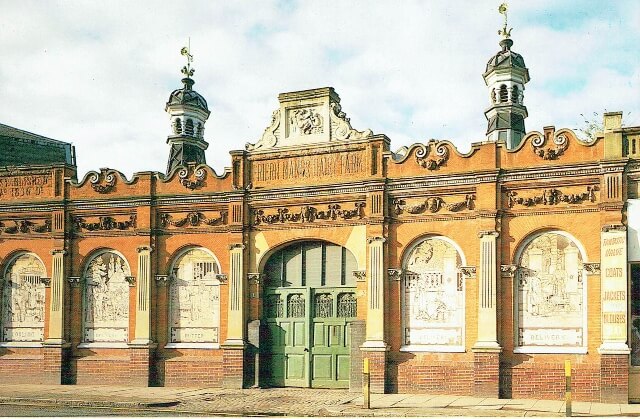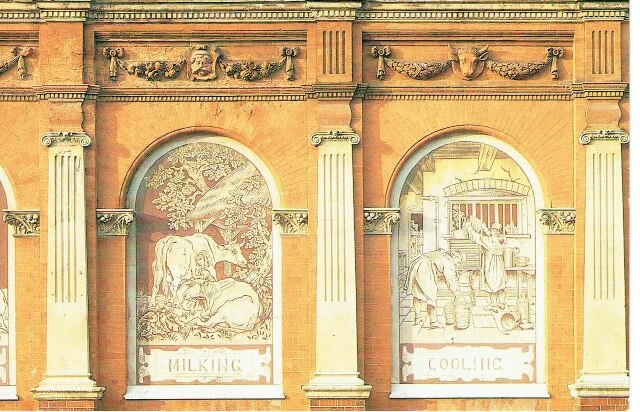The Old Dairy is located at the bottom of Crouch Hill (Haringey) at its junction with Hanley Road (Islington). These fine buildings are now a café, restaurant and public house.
Its name and the sgraffito panels on the Crouch Hill side indicate that it was connected with the dairy industry. What is the building’s history?

The original building of the Old Dairy complex, at 127 Hanley Road, was in use as a dairy from the middle of the 19th century, first by Davis & Co. and then by George Taylor. A photograph, taken during restoration, shows an 1880s advertisement for the dairy, no longer visible, on the wall behind the Crouch Hill façade. The branch of Friern Manor Farm at Hanley Road was originally rented for £25 on an 84-year lease and managed for the company by John West, who lived above the shop with his wife Elizabeth and children Harold and Mildred. The decorative building at 1-3 Crouch Hill, with its seven sgraffito panels, was built specially for the Friern Manor Dairy Farm Company on the site at the rear of Hanley Road, where the company rented cowsheds and stables. The panels are very unusual in being pictorial and situated in a street, there being very little late 19th century sgraffito work, and what there was is mostly decorative or in churches. If for no other reason, these panels make the building special.
The identity of the builder of 1-2 Crouch Hill is unknown, as is the designer of the decorative panels. The building is constructed with red rubbed bricks which have been identified as being made by Tommy Lawrence of Bracknell. This 19th century brick company, closed down after the war, was a source of bricks for Hampton Court and was synonymous with cut and rubbed brickwork. In 1889 a Mr Wells put a proposal to the Islington Vestry for a frontage of eleven shops between Hanley Road and Sparsholt Road on Crouch Hill. He also developed property on Stroud Green Road about this time. In 1890 permission was given to Mr Wells to erect houses and shops on the south side of Crouch Hill between Findon Terrace and 127 Hanley Road. At this time also, Messrs J Young & Co., built additional stables at the Friern Dairy Farm Co. premises at Hanley Road. These two seem to be likely contenders for the construction of the building.
An article on William Wise, a late 19th century freelance ceramic painter working for Mintons, suggests that he may have had some influence on the design of the panels on the Crouch End building but there is nothing to suggest that he actually designed or executed the sgraffito work. Each sgraffito panel is made up of hard red plaster laid on the bricks and then covered with a hard white plaster in which areas of the surface layer are cut away to reveal the different coloured background to make the picture relief. The panels were then sealed with linseed oil for protection. A noted practitioner of sgraffito at the time was Heywood Sumner who wrote articles on the technique and was highly regarded in the Arts and Crafts movement for his large interior designs. Similar external two-tone plaster work was carried out by F W Moody for the National Training School of Music at Kensington, since 1904 the Royal College of Organists.

For most of its history the dairy was owned and operated by the Friern Manor Dairy Company. The earliest reference to Friern Manor Farm is in the Illustrated London News of 1853 which identifies herds kept in Peckham by a Mr Wright who had offices in Farringdon Street and Grosvenor Square. Friern Manor Dairy Farm was incorporated as a Limited Company in 1887 with George Taylor as Chairman and his son, Charles Henry Taylor, as Managing Director and Secretary. The company was formed out of George Taylor and Son, dairymen of Farringdon Street, and Frederick Hornby, dairyman of Holloway Road. George Taylor appears to have lived in Lewisham but Charles Henry Taylor lived in Christchurch Road, Crouch End, until 1919 when he moved to Avenue Road, Highgate.
The company had its original Head Office at Farringdon Street and branches in south London at Peckham, Nunhead and Streatham, and in north London at Stroud Green, Holloway and Finsbury Park. In the early 1900s, the company advertised itself as a specialist supplier of Dr Gaertner’s Humanised Milk, preparations for infants and invalids, with a local farm, Park Farm, in Coppetts Road, Muswell Hill, and branches all over London. As early as 1898 the company was reported in medical journals as being one of only six dairies in England and Scotland supplying the Gaertner preparation. Later the firm diversified into supplying ice cream to south London cinemas and running milk bars in the city. It appears that the origins of the company may have been in south London, if so, why build a prestigious and expensive building in north London and not even the head office? Was the building the milk processing depot, close to the railway for easy distribution, for separating the milk and making the Gaertner preparation?
The premises were let in the 1920s to United Dairies which continued to use them until 1968 after which the building had an assortment of occupiers. The Crouch End building was listed in 1972 and the Hanley Road building in 1974. In 1997 the premises were purchased by Regent Inns plc. and opened in September of that year. This new use for the listed buildings cost the company something up to 1.5 million pounds and they went to some trouble, under the watchful eye of English Heritage, to maintain the character of the buildings by employing Nimbus Conservation in the restoration and renovation of the buildings.
The author is researching the history of the Old Dairy and the Friern Manor Dairy Company and would welcome more information about the buildings, the company and the preparation of milk.
Website editor’s note
The Friern Manor Dairy Company is often confused with the Manor Farm Dairy Company which never owned the Old Dairy, Crouch Hill. The Friern Manor Dairy Company originated in Camberwell, south London. The Manor Farm Dairy Company had its headquarters at Manor Farm, situated on the Great North Road, approximately where Aylmer Parade N2 is now situated, between Highgate and East Finchley, in north London.
Image credits
HHS Collection